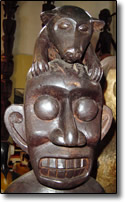
Kuching
We never did find out why Kuching is named for the Malay word for “cat”. This pleasant waterfront town is one of the few places in Borneo that feels like it has a sense of history. Across the river from a clutch of old colonial buildings is a small, whitewashed fort built to protect the settlement. Unlike peninsular Malaysia, the people here are two-thirds Christian, a mix of Chinese, coastal Malay and Dayak (from the interior of Borneo ).
One thing we missed from peninsular Malaysia was Indian food. We even went to the local Sikh temple to ask where we could find a good Indian restaurant. In a street of Chinese shop houses we found the Bollywood cafe, run by a genial old man and his wife. He told us how his father had sent him, of Indian descent, to a Chinese school to learn Cantonese, the local dialect. The ability to speak the language paid off later, during his career, when he worked with and directed Chinese colleagues.

The Sarawak Museum has a good collection of pictures and artifacts from the different cultures of the province. Here is a good place to see models of longhouses, utensils, statues, musical instruments and black-and-white pictures of former times. There are exhibits showing how traditional tattooing was performed with bamboo needles and charcoal-based ink. Statues and carving demonstrate the remarkable artistic ability of the native inhabitants. Sadly, most of the “culture” displayed in the museum is already gone. To perform important rituals, Dayaks from Malaysian Borneo sometimes summon religious leaders from over the border in Indonesia, where traditions are still strong.
